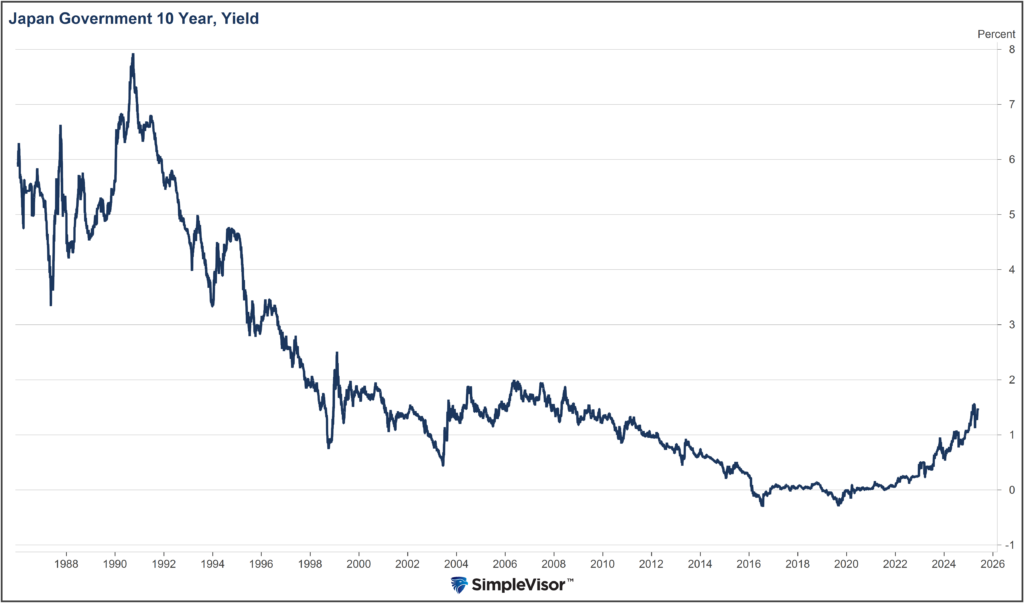In an economically challenging era where the traditional mechanisms behind monetary policy have been stretched to their limits, the Bank of Japan (BoJ) has adopted a nuanced approach that marks a significant shift from its longstanding monetary policy. Historically, Japan’s central bank has maintained an extraordinarily accommodative monetary stance, characterized by capping yields at remarkably low levels and embracing negative interest rates. This approach was rendered feasible due to Japan’s persistent limited economic growth and disinflationary pressures.
However, the landscape began to shift as inflationary forces gained momentum and the economic backdrop took on a different hue. The pivotal year of 2023 marked the onset of policy normalization by the BoJ, a move underscored by its decision to permit yields to ascend above the 1% threshold for the first time in more than a decade. Today, a glance at the financial metrics reveals 10-year and 30-year bond yields stationed at 1.60% and 3.20%, respectively. These figures not only signify the anticipation of a continuance in tightening monetary policy in response to inflation persistently breaching the BoJ’s 2% target but also highlight the yen’s enduring fragility. This weakness, especially pronounced when juxtaposed against the comparatively higher interest rates of the U.S., has compelled the BoJ to foster an environment conducive to higher interest rates, with the broader aim of stabilizing the national currency.
The backdrop to this policy shift is a landscape marked by an improving Japanese economy alongside escalating inflation rates. This economic milieu fuels speculation regarding the BoJ’s potential move to entirely abandon its long-standing policies of interest rate caps and negative interest rates. Adding depth to these conjectures are the looming concerns over fiscal sustainability, stoked by a public debt that towers at over 250% of the national GDP. The amalgamation of these factors contributes to the upward pressure on yields, weaving a complex tapestry of economic dynamics and policy responses.
For investors in Japan, the U.S., and across the globe, the uptick in Japanese yields alongside a fortifying yen spells a constellation of risks, particularly concerning the unwinding of the yen carry trade—a strategy that flourished under the regime of low Japanese interest rates. The spectre of such reversals casts long shadows, reminiscent of similar events witnessed in August 2024, underscoring the intricate interconnections within global financial markets and the pivotal role of the BoJ’s policy orientation.
As we shift focus to the broader economic and market narratives, it is imperative to underscore that the dynamics shaping yields extend beyond simplistic attributions to fiscal deficits. Despite running deficits for over four decades, and with current deficits tapering from their peaks five years ago, the relationship between deficits and interest rates is far from linear. The reduction in deficits, spurred by stronger economic growth and reduced debt issuance, illustrates a nuanced interaction where declining deficits and bolstered economic activity empower borrowers to demand higher yields. This relationship is mirrored in periods of sharp economic downturns and escalating deficits, resulting in a dip in yields.
Looking to the immediate horizon, the market’s reaction to yields is influenced by myriad factors, including narratives, trading positions, and the anticipated interventions by central banks and treasury departments aiming to safeguard financial stability. Amid these dynamics, opportunities emerge to harness movements in the bond market to enhance returns from fixed-income investments.
Delving into the specifics of bond auctions, we recently observed a 20-year Treasury auction in the United States, which, contrary to the alarmist tones in some social and traditional media outlets, could be characterized as tepid rather than catastrophic. The nuances of bond auctions reveal a complex interplay of demand and supply, with the liquidity and auction sizes of different bond maturities playing critical roles in determining auction outcomes. The portrayal of auction results often leans towards sensationalism, obscuring the underlying realities and data points that offer a more balanced perspective.
This intricate dance of monetary policy, economic indicators, and market dynamics outlines the challenges and opportunities facing global financial markets. As Japan navigates the delicate path of policy normalization, the ripples of its decisions touch shores far beyond its own, underscoring the interconnectedness of global economies and the pivotal role of informed, nuanced policy-making in steering the ship of economic stability.



